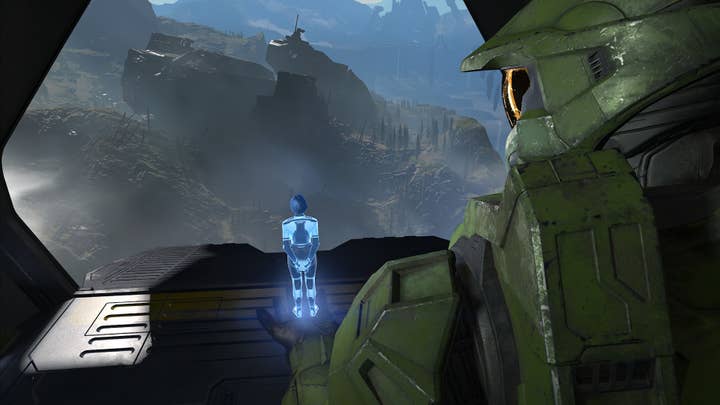Halo Infinite is a trial balloon for Game Pass' future | Opinion
A strong start for Xbox' most valuable franchise creates an opportunity to experiment in keeping players engaged long-term
The resuscitation of Microsoft's ambitions in the games sector after the missteps and failures of the Xbox One era have all revolved around one seriously ambitious goal: reshaping the industry's business models to move away from fixed hardware platforms and generations, and towards a vision of an evolving software and services platform that spans various kinds of hardware and systems.
Between the expansion into a service platform spanning Xbox consoles (the hardware itself now fragmented into two distinct performance tiers, making it easier to expand even further in future) and PC platforms, and the creation of the Game Pass service, which now boasts 25 million subscribers and a hugely impressive back catalogue of games, most of the framework for achieving that goal is in place.
There's just one missing ingredient, and it's the single biggest challenge for Microsoft in the coming years: it needs the high-profile exclusive games that will actually tip consumers over and get them to buy into this ecosystem.
The general assessment that Microsoft is now spending significantly more on content than Netflix is a fair one
That's what last year's acquisition of Zenimax / Bethesda was about, and to a large extent it's what this year's vastly larger -- in every sense -- acquisition of Activision Blizzard King is about. Once you factor in all of the company's other various investments in first-party studios and the costs associated with actually integrating its two publisher acquisitions, Microsoft's investment in getting its first-party publishing pipeline up to speed in this generation will likely be within a stone's throw of $100 billion.
That's easily the largest investment any company has ever made in the gaming space (even if the lion's share of that is the cost of the ABK acquisition), and a clear sign of just how seriously Microsoft takes the task of getting high-quality content onto the Xbox platform generally and Game Pass more specifically. For comparison, Netflix's global spend on content last year was somewhere shy of $17 billion, and only c.$5 billion of that was spent on original content creation; it's an apples to oranges comparison since Microsoft's acquisitions and investments are a multi-year project, of course, but the general assessment that Microsoft is now spending significantly more on content than Netflix is a fair one.
In light of that enormous investment -- and the equally enormous challenge it's designed to overcome -- the company would be justified in feeling very, very good about the news this week that Halo Infinite has reached 20 million players in the months since its launch, making it the biggest ever launch for a Halo game.

That statement needs about a dozen qualifications and footnotes attached to it, of course; there's no credible direct comparison that we can make between the player numbers for previous Halo titles, which launched solely as full-price packaged or digital download games, and the player numbers for a game whose multiplayer component is free-to-play and whose single-player campaign is available at no additional cost to those 25 million Game Pass subscribers. It's probably a safe bet that the actual revenues from the launch of Halo Infinite are the lowest in the series' history, given how few players will have needed or wanted to buy the $60 standalone product -- but for the purposes of the future Microsoft is trying to build and the role it needs its first-party games to play, that barely matters compared to the raw number of players the game has been able to reach and the extent of engagement with Game Pass it has been able to drive.
It's a safe bet that the revenues from Halo Infinite are the lowest in the series' history -- but for Microsoft, that barely matters compared to the raw number of players and the extent of engagement
Those old enough to have been through a few boom and bust cycles with online ventures over the past quarter-century might have an instinctive wince reaction to that statement. How many times have we heard that it's user numbers and engagement that matter, not revenues -- often from companies that are either on the road to ruin, or which will ultimately be forced to completely debase their products and services in a desperate wild goose chase after profitability some years down the line?
In Microsoft's case, though, the point is that they're selling a service right from the outset -- and in the case of Game Pass, a fairly expensive service, which at $15 per month probably isn't too far off the amount most casual or mid-core consumers spend on software right now. They're not building user numbers and engagement with some vague aspiration towards monetisation down the line, and while it's likely that price hikes will eventually be needed to balance the books, a $180 per year subscription fee (at the high end, admittedly -- some users are on cheaper packages) is a very solid per-user revenue figure right out of the blocks.
The challenge for Microsoft isn't figuring out monetisation -- the monetisation model is right there in black and white -- it's figuring out how to scale that service, attracting new users while retaining existing users with software that keeps them engaged month to month.
This intrinsically changes the set of incentives and business model considerations around any Xbox first-party title, whose objective now shifts from "sell units" to "engage players, and keep them engaged". That sounds like a subtle difference, but it's not -- especially in terms of that "keep them engaged" objective, which creates a huge incentive for studios to think of their games as live services, continually evolving to keep players on board.

That doesn't have to mean that everything turns into what we think of conventionally as a "service game" -- that model works for many kinds of multiplayer title, but many other kinds of game simply don't work when you try to contort them to fit into a box shaped for a service game like Destiny or Fortnite, as certain publishers have been discovering to their great chagrin in recent years. Looked at optimistically, it opens the door for developers to think about new possibilities for games that evolve and expand post-launch -- and to radically rethink their ideas about what post-launch content does and how players relate to it.
Think about Halo Infinite as an example. I don't know for sure what 343 plans to do with their game in future; the multiplayer aspect is broadly organised into seasons in a manner that will be familiar to anyone who's subjected themselves to an online shooter in recent years, but plans for post-launch singleplayer content are far less clear. Generally speaking you'd expect a game like this launching on any other platform to be followed up with a few major paid DLC expansions which players can either buy individually or up-front as part of a premium bundle
-- a model that more or less works commercially, but is fairly unpopular with players and ends up delivering very rapidly diminishing returns, especially if any of the DLC packs is judged to be substandard.
If Microsoft can perfect that formula, it would be an incredibly powerful tool in its drive to make Game Pass into a dominant part of the industry
Halo Infinite, with its open-world areas from which other, inaccessible parts of the game world are clearly visible, seems fairly well primed for this kind of approach; but crucially, the incentive to upsell players and get them to pay for new DLC is largely gone, replaced with an incentive to find a way to consistently engage players, giving them compelling new content and helping to encourage them to stay subscribed to Game Pass.
Some of the resulting objectives are the same -- regardless of whether you're charging money or not, keeping players engaged is still a key part of the challenge -- but moving the commercial transaction one step away, such that players are getting these DLC packs as part of an existing subscription rather than being faced with a price tag decision, makes a huge difference to their perception. At an extreme, this whole scenario stops being a question of "milking" a game post-launch by charging for extra content (which some portion of your playerbase will always fervently believe was maliciously stripped out of the game pre-launch in order to give the publisher a chance to charge more money for it, no matter how ridiculous that contention is in most cases), and starts being something more like the long-standing dream of episodic content -- new chapters in an ongoing story that players are already invested in, which become available to Game Pass subscribers every few months.
Episodic gaming is not, in itself, anything new; you could point to things like the old shareware models for PC games as an example of proto-episodic gaming, and there were some interesting efforts at making real episodic games as far back as the early 2000s -- Capcom's seven-volume JRPG El Dorado Gate, which released on a bi-monthly schedule on the Dreamcast starting in late 2000, being a notable, albeit far from successful, pioneer.
More recently we've seen a lot of story-driven indie titles embrace an episodic approach, although those games often struggle with the reality of how front-loaded the development process is (it's not the case that dividing your game into six parts also divides development cost and effort into six parts, as most of the work needs to be done before the first part ever sees the light of day) and, perhaps unsurprisingly in an era of binge-watching, can sometimes fail to really find their audience until all of the parts are available as a bundle.

Game Pass turns the tables. By taking away the paid transaction, it shifts the conversation on the consumer side away from the business model of DLC and towards the narrative and interactive value of the episodic content itself; yes, of course the consumer is still ultimately paying through their subscription revenue, but the psychology of the transaction and the way people calculate value for money is changed dramatically.
For Game Pass itself, being able to release a solid chunk of content from a major game like Halo to subscribers a couple of times a year or more is precisely the kind of red meat that needs to be stuffed into the ravenous maw of a subscription service that will, ultimately, live or die on its ability to keep players engaged with fresh content on a month-to-month basis. Just like Disney+ focuses on keeping subscribers engaged by having some major new content from Marvel or Star Wars available to stream each month -- Hawkeye last month, Boba Fett this month, Moon Knight next month, and so on -- Microsoft's objective will be to have its tentpole franchises delivering something new on Game Pass on a steady basis, with episodic content filling in the gaps between major new title releases.
We shouldn't understate the challenges to overcome in terms of the development process for that kind of content, of course; many developers reading this are probably feeling exhausted just thinking about the punishing work schedules that will result if the demand for post-release content every few months is not extremely carefully and professionally managed -- something that a lot of studios, bluntly, aren't very good at. Avoiding its studios becoming high-turnover sweatshops suffering under never-ending crunch will be a very big task for Microsoft if it decides to embrace this model for its major titles.
Well-managed, though, this approach makes episodic gaming make sense in a way that it never really has before, and could open doors for game creators to really plan out a whole evolving narrative and gameplay journey spanning years, which is exciting creatively even if the potential for it to go awry is always lurking in the background. The notion of a game like Halo Infinite taking its 20 million player launch numbers and using that engagement to evolve into a service with ongoing multiplayer updates and regular releases of new chapters in the single-player saga makes a huge amount of sense, and arguably mirrors Microsoft's broader strategy around the Xbox platform itself.
If Microsoft can perfect that formula, it would be an incredibly powerful tool in its drive to make Game Pass into a dominant part of the industry; only a handful of major exclusives taking this approach would give Game Pass a major new content release every month or so, and turn the service into an essential subscription for any consumer who loves those worlds, characters and experiences. Watching how 343 handles Halo Infinite in the coming months and years will be a strong indicator for how Microsoft sees the future of gaming overall -- and what it's prepared to do, above and beyond opening up its wallet, to get us there.

